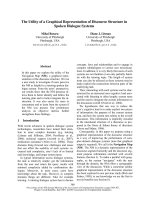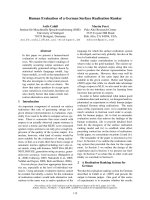Báo cáo khoa học: "Genetic variability of a scattered temperate forest tree: Sorbus torminalis L. (Crantz)" ppsx
Bạn đang xem bản rút gọn của tài liệu. Xem và tải ngay bản đầy đủ của tài liệu tại đây (86.65 KB, 9 trang )
Original article
Genetic variability of a scattered temperate forest tree:
Sorbus torminalis L. (Crantz)
Brigitte Demesure
a,*
, Bénédicte Le Guerroué
a
, Géraldine Lucchi
a
,
Daniel Prat
b
and Rémy-Jacques Petit
c
a
Conservatoire génétique des arbres forestiers, Office National des Forêts, Campus INRA, F-45160 Ardon, France
b
Laboratoire de génétique et amélioration des arbres forestiers, INRA, F-45160 Ardon, France
c
Laboratoire de génétique des arbres forestiers, INRA, BP. 45, F-33611 Gazinet Cedex, France
(Received 20 January 1999; accepted October 4, 1999)
Abstract – Genetic variation has been assessed in 73 (mostly French) populations of the wild service tree (Sorbus torminalis) using
15 isozymes loci. In spite of a relatively high coefficient of genetic differentiation among populations (
F
ST
= 15%), only a weak geo-
graphical structure was detected. This may be explained by the small size and young age of the populations due to the importance of
founder effects, combined with the high levels of seed flow among populations. These features are typical of species characterised by
metapopulation dynamics.
genetic diversity / differentiation / metapopulation / Rosaceae / spatial structure
Résumé
– Variabilité génétique d’une espèce forestière disséminée : Sorbus torminalis L. (Crantz). De nombreuses études se
sont intéressées à la diversité génétique des plantes rares, menacées de disparition, ou à celles largement répandues qui présentent un
grand intérêt économique. Par contre, le cas des espèces ayant une aire de répartition importante mais présentant des densités faibles
reste peu abordé, en particulier chez les arbres forestiers. Dans les forêts tempérées, les arbres forestiers disséminés occupent une
place secondaire. L’alisier torminal (
Sorbus torminalis) est une espèce fruitière disséminée au comportement post-pionnier nomade.
Ses graines sont dispersées par les oiseaux. 67 populations françaises et 6 populations d’Europe centrale ont été étudiées à l’aide des
isozymes. Une forte différentiation entre populations a été trouvée (
F
ST
= 15 %), combinée à une faible structuration géographique.
Ceci peut s’expliquer par les effets de fondation importants liés au comportement écologique de l’espèce, et aux flux de graines entre
populations éloignées, liés à la dissémination par des oiseaux. Le modèle en métapopulation, avec des populations subissant des phé-
nomènes de colonisation et d’extinction, mais restant interconnectées par des flux de gènes, semble particulièrement bien s’appliquer
à cette espèce. Au vu de ces résultats, une gestion permettant l’implantation de l’alisier dans de nouveaux sites pouvant recevoir des
flux de gènes des populations préexistantes doit être encouragée.
Rosaceae / diversité génétique / métapopulation / differentiation / structure spatiale
1. INTRODUCTION
Since the development of isozyme markers, thou-
sands of population genetic studies of wild plants,
including a large proportion dealing with forest trees,
have been carried out either in temperate or in tropical
regions. These studies have pointed out the importance
of the size of the geographic range of the species for
predicting levels and organisation of genetic diversity:
in general, species with widespread distributions main-
tain higher levels of genetic diversity at allozyme loci
than species with narrow or endemic distribution [10,
Ann. For. Sci. 57 (2000) 63–71 63
© INRA, EDP Sciences 2000
* Correspondence and reprints
B. Demesure et al.
64
11, 32]. Similarly, allozyme surveys have shown that
geographically restricted species that are locally abun-
dant contain fewer polymorphic loci and a lower mean
number of alleles per locus than widespread congeneric
species [14, 15]. The importance of the size of the popu-
lation has also been investigated for a more limited num-
ber of plant species. These studies have shown that
common species with large population sizes are more
variable than rare species [37]. However, little is known
about trees with widespread distribution but having low
population densities, i.e. between 0.1 and 30 adults by
hectare. This lack of knowledge is due first to the low
economic impact of these species compared to social for-
est trees such as Quercus spp. or Picea abies in Europe
and second to the difficulty to inventory them. Yet the
scattered trees contribute to increase the biodiversity of
the forest, by their presence but also because many ani-
mal species rely on them.
Nevertheless, some results concerning genetic diversi-
ty of disseminated trees based on enzymes have started
to appear recently both in temperate countries [22, 30,
33, 40] as well as in tropical ones [4, 15, 37]. These
species generally show lower genetic diversity than
widespread species. But comparisons with more abun-
dant species are difficult, because sampling of scattered
species often involves few populations with limited sam-
ple sizes per population. Here, we present the results of
an investigation of the genetic variability of a scattered
tree species, the wild service tree, Sorbus torminalis (L.)
Crantz, based on an intensive sampling of populations in
France. This member of the Rosaceae family is one of
the most economically important wild fruit trees in
Europe. It is a scattered species (0.1 to 30 adults per
hectare) which never occurs in pure populations. It
grows on all types of soils. It is a post-pioneer tree that
colonises disturbed areas and forest edges. Although the
trees are generally overgrown by more competitive
species such as Quercus or Fagus [5], individual trees
can be very valuable when they benefit from good soil
and light conditions. Sorbus torminalis is a diploid
species (2n = 34) according to Liljefors [20]. This
species is insect pollinated and the seeds are dispersed
by birds. A recent study on Sorbus commixta in Japan
[45] reports that extraction of seeds from the pulp is nec-
essary for their germination. Sorbus torminalis is also
able to propagate asexually through the production of
suckers. The natural distribution of Sorbus torminalis is
rather large, from the north of Magrehb to the south of
Sweden and from the east of Great Britain to the north of
Iran. It grows mostly in lowlands. In France, the most
important populations of Sorbus torminalis are located in
the south-west and in the north-east of the country.
Hybridisation with other Sorbus species, especially with
Sorbus aria, another diploid species, is considered to be
frequent in Europe [9].
2. MATERIALS AND METHODS
2.1. Materials
Sixty seven indigenous populations of Sorbus tormi-
nalis were sampled in France (figure 1). The collection
also included six populations originating from other
countries in Europe: Slovakia (3 populations), Slovenia,
Bulgaria, and Switzerland (one population each)
(table I). A population sample consists of dormant buds
from at least 11 mature trees or young stems separated
from each other by at least 50 m (to avoid sampling the
same clone) on an area of 20 to 50 ha. In such conditions
the sampling of individuals may or not be exhaustive,
depending on the local density. To allow comparisons
among regions, French populations were grouped
according to their geographical proximity. Several geo-
graphical clustering of populations were tested. The
results of gene diversity and differentiation were very
similar. The final choice (eight groups) resulted from a
compromise between homogeneous number of popula-
tions per group and geographical proximity (figure 1).
Fig.1. Geographical distribution of populations of Sorbus tormi-
nalis
. Populations were clustered in 8 groups according to their
geographical proximity. Symbols for the groups are group 1
■,
group 2
▼▼, group 3 ●, group 4 ◆◆, group 5 ★, group 6 ●●, group
7
▲, group 8 ★★.
Allozyme diversity in Sorbus torminalis
65
Table I. Geographic origin, and genetic diversity estimates and inbreeding coefficient (based on 15 allozyme loci) for 73 popula-
tions of
Sorbus torminalis.
N
a
, number of alleles per locus; H
o
, observed heterozygosity; H
e
, expected heterozygosity; F
IS
, heterozygote deficit.
Populations Longitude Lattitude Groups Sample size N
a
H
o
H
e
F
IS
Assenoncourt 06°45'E 48°47'N 8 21 1.600 0.116 0.151 0.232
Aulnay 00°28'E 46°00'N 4 19 1.733 0.175 0.179 0.022
Avants Monts 02°41'E 43°26'N 5 12 1.333 0.100 0.080 –0.250
Bellême 00°31'E 48°24'N 3 11 1.533 0.145 0.164 0.116
Bercé 05°02'E 45°08'N 3 18 1.667 0.130 0.175 0.257
Bois rogue 00°13'W 46°59'N 4 20 1.600 0.105 0.173 0.393
Bourdogne 00°25'E 47°48'N 7 20 1.800 0.157 0.197 0.203
Bourg St Andéol 04°34'E 44°25'N 6 18 1.600 0.126 0.135 0.067
Braconne 00°20'W 46°30'N 4 20 1.600 0.149 0.169 0.118
Byans sur le Doubs 05°49'E 47°05'N 8 19 1.533 0.128 0.120 –0.067
Canjuers 06°25'E 43°38'N 6 20 1.533 0.135 0.153 0.118
Chantilly 02°29'E 49°10'N 1 20 1.800 0.186 0.200 0.070
Charve Chave 03°22'E 46°00'N 7 19 1.667 0.116 0.150 0.227
Chatrices 04°57'E 49°01'N 8 14 1.733 0.177 0.201 0.119
Chillou 00°39'E 46°35'N 4 20 1.733 0.137 0.186 0.263
Chizé 00°17'W 46°03'N 4 20 1.733 0.137 0.230 0.404
Choeurs Bommiers 02°00'E 46°51'N 2 21 1.600 0.139 0.202 0.312
Chouanière 01°21'W 47°53'N 3 20 1.667 0.143 0.152 0.059
Claix 00°02'E 45°32'N 4 20 1.600 0.113 0.146 0.226
Corbières Occidentales 02°17'E 43°02'N 5 23 1.733 0.142 0.160 0.113
Croix aux bois 04°47'E 49°18'N 1 20 1.533 0.107 0.127 0.157
Crugny 03°44'E 49°16'N 1 19 1.467 0.123 0.147 0.163
Dreux 01°23'E 48°46'N 2 20 1.667 0.133 0.161 0.174
Ferrières 02°43'E 48°50'N 2 26 1.600 0.120 0.164 0.268
Fontainebleau 02°37'E 48°25'N 2 18 1.447 0.095 0.093 –0.022
Fossemanant 02°08'E 49°49'N 1 22 1.667 0.144 0.170 0.153
Gardiole 05°41'E 43°34'N 6 19 1.600 0.126 0.122 –0.033
Gatinalière 00°20'E 46°59'N 4 21 1.600 0.169 0.152 –0.112
Gâvre 01°50'W 47°31'N 3 20 1.667 0.157 0.165 0.048
Gouffern 00°01'W 48°49'N 3 20 1.800 0.155 0.181 0.144
Grand Vallon 06°04'E 44°11'N 6 13 1.467 0.082 0.119 0.311
Grésigne 01°44'E 44°02'N 5 15 1.600 0.132 0.160 0.175
Guerche 01°14'W 47°52'N 3 20 1.733 0.133 0.168 0.208
Gurs 00°48'W 43°15'N 5 15 1.667 0.129 0.143 0.098
Harth 07°23'E 47°46'N 8 20 1.800 0.234 0.223 –0.049
Hez Froidemont 02°16'E 49°24'N 1 20 1.733 0.147 0.142 –0.035
Hospice de Chalais 00°04'W 45°14'N 4 20 1.600 0.137 0.132 –0.038
Hurecourt 06°02'E 47°55'N 8 12 1.533 0.162 0.164 0.012
Isle s/le Doubs 06°34'E 47°26'N 8 18 1.667 0.141 0.188 0.250
Le Plan 01°05'E 43°08'N 5 12 1.600 0.106 0.150 0.293
Liffré 01°28'W 48°13'N 3 20 1.667 0.103 0.144 0.285
Malmifait 01°56'E 49°35'N 1 20 1.600 0.144 0.156 0.077
Mareuil 00°31'E 46°34'N 4 17 1.733 0.170 0.191 0.110
Mas d'agenais 00°09'E 44°24'N 5 22 1.533 0.123 0.156 0.212
Montceau 04°21'E 47°29'N 2 13 1.600 0.122 0.161 0.242
Mouliére 00°32'E 46°49'N 4 19 1.667 0.221 0.186 –0.188
Nanc les St Amour 05°17'E 46°25'N 7 13 1.467 0.154 0.142 –0.085
Orléans 01°52'E 47°56'N 2 21 1.533 0.083 0.185 0.551
Pleumartin 00°52'E 46°37'N 4 19 1.667 0.155 0.173 0.104
Puygareau 00°17'E 46°50'N 4 22 1.667 0.144 0.197 0.269
Rambouillet 01°47'E 48°40'N 2 21 1.667 0.125 0.163 0.233
Ravières 04°16'E 47°44'N 2 22 1.800 0.128 0.189 0.323
Roche de bran 00°28'E 46°42'N 4 20 1.667 0.153 0.173 0.116
Roche posay 00°44'E 46°47'N 4 19 1.667 0.151 0.162 0.068
Rouvroy sur Marne 05°29'E 48°23'N 8 20 1.600 0.173 0.170 –0.018
St André 00°13'W 48°52'N 3 20 1.533 0.097 0.131 0.260
B. Demesure et al.
66
2.2. Electrophoresis
The buds sampled (3 to 5 per tree) were ground in a
cooled mortar containing the protein extraction buffer
(360 µL for 200 mg of plant material), which was a Tris-
HCl buffer (0.02 M, pH = 7.6) supplemented with 1.0%
bovine serum albumin, 2% polyethyleneglycol 8000, 1%
dithiothreitol, 14 µM β-mercaptoethanol. The
homogenates were centrifuged at 15 000 g for 20 min at
4 °C. The extracts were stored at –80 °C until analysis.
The electrophoretic migration took place at 4 °C in hori-
zontal starch gels under an electric field of 80 mV cm
–1
for one night.
Of the l8 enzyme systems tested (some were tested
with various substrates and staining procedures) the fol-
lowing 11 were finally retained because of the repro-
ducible patterns and of the straightforward genetic
interpretations:
AAP, E.C. 3.4.11.1 (alanine aminopepti-
dase, one locus: AAP-1), ACP, E.C. 3.1.3.2 (acid
phospatase, one locus: ACP-1), ADH, E.C. 1.1.1.1 (alco-
hol dehydrogenase, one locus: ADH-1), GOT, E.C.
2.6.1.1 (glutamate oxaloacetate transaminase, one locus:
GOT-2), IDH, E.C. 1.1.1.42 (isocitrate dehydrogenase,
two loci: IDH-1, IDH-2), PRX, E.C. 1.11.1.7 (peroxi-
dase, two loci: PRX-1, PRX-2), ME E.C. 1.1.1.40 (malic
enzyme, one locus: ME-1), MR E.C. 1.6.99.2 (mena-
dione reductase, two loci: MR-1, MR-2), PGM, E.C.
5.4.2.2 (phosphoglucomutase, two loci: PGM-1, PGM-
2), 6PGD E.C. 1.1.1.44 (6-phosphogluconate dehydroge-
nase, one locus: 6PGD-1) SKDH, E.C. 1.1.1.25 (shiki-
mate dehydrogenase, one locus: SKDH-1). Standard
staining procedures [2, 28, 39, 42] were adapted with
some minor modifications. Segregation analysis of poly-
morphic systems (Demesure and Le Guerroué, unpub-
lished data) showed that these enzymes were encoded by
15 loci. The alleles were numbered from the fastest to
the slowest.
2.3. Data analysis
Geographical variation of gene diversity and allele
frequencies were tested in different ways. Several
genetic diversity parameters were calculated, for all
French populations, but also for each regional group. In
addition, a comparison between the French populations
and the Central European ones was carried out. Allele
frequencies were calculated for each population and gene
diversity parameters estimated on a within population
basis. The number of alleles per locus (N
a
) was calculat-
ed over all the loci, as well as Nei's genetic diversity
indices [26, 27]. Population differentiation can be sum-
marised by F-statistics (F
IS
, F
ST
) as defined by Wright
[44], for groups of populations [13]. The similarity
between pairs of populations was measured by Nei’s
unbiased genetic distances corrected for small sample
sizes [27]. Dendrograms were produced based on this
distance using the UPGMA method [13]. All estimators
of the parameters of interest (allele frequencies, genetic
diversity and differentiation) were computed using POP-
GENE 1.2 [46]. Another useful parameter to evaluate
differences in levels of diversity H across populations is
the coefficient of variation of H (standard deviation of H
Table I. Continued.
Populations Longitude Lattitude Groups Sample size N
a
H
o
H
e
F
IS
St Babel 03°16'E 45°34'N 7 14 1.533 0.167 0.150 –0.113
St Gobain 03°50'E 49°35'N 1 11 1.467 0.061 0.134 0.545
St Vallier 06°08'E 48°10'N 8 24 1.667 0.127 0.175 0.274
Ternay 00°21'W 47°08'N 4 20 1.533 0.114 0.140 0.186
Trois Fontaines 04°55'E 48°46'N 8 14 1.600 0.178 0.192 0.073
Valay 05°38'E 47°20'N 8 30 1.533 0.151 0.151 0.000
Valbonne 04°34'E 44°16'N 6 19 1.467 0.086 0.120 0.283
Vendresse 04°46'E 49°37'N 1 16 1.733 0.154 0.166 0.072
Vierzon 02°27'E 47°10'N 2 21 1.467 0.095 0.118 0.195
Villasavary 01°59'E 43°13'N 5 15 1.533 0.102 0.090 –0.133
Wasselone 07°25'E 48°36'N 8 11 1.467 0.108 0.113 0.044
Central Europe
Bulgarie 27°05'E 43°18'N EC 20 1.733 0.105 0.117 0.103
Slovaquie 1 21°36'E 49°07'N EC 42 1.667 0.070 0.100 0.300
Slovaquie 2 19°18'E 48°30'N EC 34 1.800 0.152 0.139 –0.094
Slovaquie 3 21°03'E 48°48N EC 65 1.800 0.127 0.143 0.112
Slovénie 13°26'E 45°16'N EC 29 1.600 0.123 0.122 –0.008
Suisse 09°04'E 45°30'N EC 86 1.800 0.152 0.179 0.151
Allozyme diversity in Sorbus torminalis
67
divided by the mean). One-way analysis of variance was
used to investigate the difference between groups of pop-
ulations, based on the parameters estimated in each indi-
vidual population. For each parameter (N
a
, H
o
, H
e
and
F
IS
) considered, we therefore tested whether significant
(P < 0.05) differences occurred among groups. For the
comparison between France and Central Europe, stan-
dard errors of diversity parameters were based on the
sampling of loci.
Multivariate analyses (factorial analysis) based on the
presence or absence of each detected allele at each locus
were also performed. For each allele in each individual,
the data was coded as 2, 1 or 0 when the allele was
observed in the homozygous condition, in the heterozy-
gous condition or not observed, respectively. In order to
assess the effect of geographical distances between
populations on their genetic distances, multilocus genetic
distances were computed between all pairs of popula-
tions, following Degen and Scholz [3]. All pairs of popu-
lations were then classified in ten geographic distance
classes from 0 to 1000 km, and the relationship between
genetic and geographical distances was tested against the
hypothesis of random spatial genetic structure by permu-
tation analysis [3].
3. RESULTS
3.1. Overall genetic variability of Sorbus torminalis
in France
Nine of the 15 loci were polymorphic in France
(table II), with a range of 5 to 9 polymorphic loci in each
population. The number of alleles per polymorphic locus
ranged from 2 to 5 with a mean of 2.0. In France, the
average of observed and expected heterozygosities were
respectively 0.137 and 0.190 (table II). The F
IS
values
were positive at six loci and negative at three other ones
(ADH, 6-PDH, IDH-1): the combined value over all loci
was 0.15. The coefficient of differentiation among popu-
lations, F
ST
, ranged from 0.10 to 0.32 across loci, with
an overall value of 0.15 (table II). The coefficient of
variation of H across all 73 populations was 0.20.
Most alleles were found throughout France. However,
allele e of PGM-2 was only observed in the Pyrénées
(group 5) and allele d of ADH was restricted to north of
France (group 1). In addition, allele b of AAP was absent
in group 5 and allele b of SKDH was absent
from group 1. The mean number of alleles per group
(table III) varied very little: from 1.53 (group 6) to 1.60
(group 2), and no significant group effect was detected
by the analysis of variance. Observed and expected het-
erozygosities ranged from 0.111 (group 6) to 0.154
(group 8), and from 0.130 (group 6) to 0.172 (group 4)
respectively. Here, the analysis of variance revealed
significant differences among groups (P = 0.02 for H
o
and P = 0.01 for H
e
). The mean within-population het-
erozygote deficit (F
IS
) ranged from 0.07 (group 7) to
0.28 (group 2), with no significant differences among
groups. The coefficient of genetic differentiation (
F
ST
)
was computed in each of the eight groups. It ranged from
0.08 in Brittany (group 3) to 0.15 in the southwest of
France (group 4).
Table II. Genetic diversity estimates per locus among the
French populations and the Central European ones.
N
a
, number
of alleles per locus;
H
o
, observed heterozygosity; H
e
, expected
heterozygosity;
F
IS
, heterozygote deficit; F
ST
differentiation
coeficient; SD, standard deviation.
France Locus N
a
H
o
H
e
F
IS
F
ST
ADH 4 0.421 0.473 –0.00 0.11
ACP 1 – – – –
6-PDH 2 0.361 0.393 –0.03 0.12
PRX-1 2 0.102 0.296 0.56 0.24
PRX-2 2 0.094 0.131 0.22 0.10
ME 3 0.488 0.647 0.15 0.11
SKDH 2 0.031 0.130 0.62 0.32
AAP 2 0.082 0.155 0.25 0.27
IDH-1 2 0.099 0.106 –0.04 0.11
IDH-2 1 – – – –
PGM-1 1 – – – –
PGM-2 5 0.382 0.521 0.13 0.16
MR-1 1 – – – –
MR-2 1 – – – –
GOT-2 1 – – – –
Mean 2.0 0.137 0.190 0.15 0.15
SD 1.2 0.178 0.221
Central Europe
ADH 3 0.319 0.317 –0.01 0.04
ACP 1 – – – –
6-PDH 2 0.291 0.288 –0.15 0.07
PRX-1 2 0.048 0.207 0.77 0.14
PRX-2 2 0.022 0.029 0.41 0.02
ME 4 0.565 0.629 0.03 0.12
SKDH 2 0.026 0.047 0.40 0.05
AAP 2 0.008 0.030 0.60 0.03
IDH-1 2 0.118 0.117 –0.04 0.03
IDH-2 1 – – – –
PGM-1 1 – – – –
PGM-2 5 0.428 0.529 0.13 0.06
MR-1 1 – – – –
MR-2 1 – – – –
GOT-2 3 0.125 0.131 –0.07 0.10
Mean 2.1 0.130 0.155 0.09 0.08
SD 1.2 0.411 0.203
B. Demesure et al.
68
3.2. Comparison of French populations with
central European populations
Ten of the 15 loci were polymorphic in Europe
(table II). The locus GOT-2 was polymorphic only in 3
populations (two in Slovakia and one in Bulgaria). One
rare allele appears in the eastern European populations at
the locus ME. There were no consistent differences
between the French and the Central European popula-
tions groups (table III). It can be noticed that the number
of alleles is slightly higher (2.1) and the value of the F
ST
(0.08) lower for the eastern European populations than
for the French populations (table II). However, the
analysis of variance based on the differences across loci
did not detect any significant differences between the
French populations and Central European ones.
3.3. Geographic structuring of the diversity
in France
The UPGMA dendrogram using Nei's unbiased dis-
tance (figure 2) did not reveal any clustering of geo-
graphically close populations. A multivariate analysis
indicates the same lack of geographic structure (data not
shown). However, the analysis of the correlation
between Nei’s genetic distances and geographic dis-
tances revealed a slight but significant positive relation-
ship at distances up to 120 km (figure 3).
4. DISCUSSION
Our results for the wild service tree are consistent
with those obtained for allozyme markers in most forest
trees studied to date: little differentiation among popula-
tions and a comparatively high level of genetic diversity.
The estimates of genetic variation at the species level
that we obtained in S. torminalis (P = 66%, A = 2.20,
H
e
= 0.185) were very close to those obtained by
Hamrick et al. [11] in long-lived woody perennials
(P = 65%, A = 2.22, H
e
= 0.177). Similarly, at the within
population level, results for S. torminalis (P = 57%,
A = 1.62, H
e
= 0.156 ) are very close to those of the other
trees (
P = 49%, A = 1.76, H
e
= 0.148). The diversity val-
ues for S. torminalis are however lower than those
obtained by Raspé et al. for Sorbus aucuparia in Europe
[33] within population (P = 63%, A = 2.25, H
e
= 0.212)
and within species (P = 90%, A = 3.70, H
e
= 0.229). The
difference observed between the two species may be
explained by ecological differences and postglacial his-
tory. Indeed
Sorbus aucuparia grows in relatively wet
and cool climate, consequently it is confined to mountain
areas in the southernmost part of its range, and it can be
found at high latitudes. On the other hand, Sorbus tormi-
nalis
is found in drier habitats, in the plains at lower lati-
tudes, and is absent at high altitudes. Hence, it is likely
that during the last ice-age the climate was more adapted
to Sorbus aucuparia which could persist in numerous
small populations in glacial refugia, and maintain higher
levels of diversity. Our results for
S. torminalis indicate
that the genetic diversity is equally distributed in France.
No strong differences can be noted for the mean number
of alleles per population. The coefficient of variation of
H (0.20) is only slightly larger than that observed in a
compilation of 62 outcrossing tree species (0.17) (R.J.
Petit, in prep.), indicating that levels of diversity are not
especially heterogeneous. Although still small compared
to herbaceous species, the observed
F
ST
value (0.15) is
however higher than that reported in other forest tree
species (e.g.,
F
ST
= 0.06 for S. aucuparia, [33];
Table III. Genetic diversity measures within the 8 French groups and the central European group.
Region N
a
H
o
H
e
F
IS
F
ST
Group 1 (SD) 1.62 (0.13) 0.133 (0.037) 0.155 (0.023) 0.14 (0.17) 0.10
Group 2 (SD) 1.60 (0.11) 0.115 (0.020) 0.160 (0.034) 0.28 (0.15) 0.12
Group 3 (SD) 1.66 (0.09) 0.133 (0.022) 0.160 (0.017) 0.17 (0.09) 0.08
Group 4 (SD) 1.65 (0.07) 0.147 (0.029) 0.172 (0.024) 0.14 (0.16) 0.15
Group 5 (SD) 1.58 (0.14) 0.119 (0.018) 0.131 (0.036) 0.09 (0.20) 0.11
Group 6 (SD) 1.53 (0.07) 0.111 (0.025) 0.130 (0.014) 0.14 (0.15) 0.11
Group 7 (SD) 1.62 (0.15) 0.149 (0.022) 0.160 (0.025) 0.07 (0.18) 0.10
Group 8 (SD) 1.61 (0.10) 0.154 (0.036) 0.168 (0.033) 0.08 (0.12) 0.11
Central Europe (SD) 1.73 (0.08) 0.122 (0.031) 0.133 (0.027) 0.09 (0.13) 0.08
Overall mean (SD) 1.63 (0.10) 0.134 (0.031) 0.156 (0.030) 0.13 (0.15) 0.15
N
a
, number of alleles per locus; H
o
, observed heterozygosity; H
e
, expected heterozygosity; F
IS
, heterozygote deficit; F
ST
differentiation coeficient;
SD, standard deviation.
Allozyme diversity in Sorbus torminalis
69
F
ST
= 0.03 for Quercus petraea, [47]; F
ST
= 0.05 for
Prunus avium, [6]). It is also of comparable magnitude
to the estimate obtained Prat & Daniel in a previous
more limited study of the species (
F
ST
= 0.10) [29].
According to Hamrick et al. [11], the mean F
ST
for trees
with animal-dispersed seeds (0.05) is much lower than
the value observed in Sorbus torminalis. Interestingly,
other authors have also reported relatively high F
ST
val-
ues for scattered species having small populations: 0.33
for Ulmus laevis [23], 0.18 for Ulmus minor [21], 0.13
for Acer platanoides [34], 0.13 for Ocotea tenera [7],
0.20 for Alnus glutinosa [30]. Allozyme studies show
clearly that population subdivision promotes differentia-
tion: values of F
ST
are higher in subdivided than in con-
tinuous habitats [1, 31]. Most disseminated tree species
are not randomly mating, due to their scattered distribu-
tion and pollination by vectors which fly over short dis-
tances only [19]. Therefore genetic drift can have a great
importance in their evolution. Although Sorbus tormi-
nalis seems to be mainly outcrossing, as suggested by
the small heterozygote deficit in the populations, a rapid
divergence between populations can appear. The high
F
ST
value can also be explained by founder effects.
Indeed, S. torminalis is a nomad species and its popula-
tions have a rapid turnover. Theoretical studies have
shown that founding events may increase differences
between young populations, depending notably on the
number of individuals involved in the founding events
and the number of source populations from wich they are
drawn [41].
Hence, the major result of this study is the combina-
tion of the relatively high F
ST
and the weak geographic
structure. The distogram indicates that populations sepa-
rated by less than 150 km are more related than those
further apart, but the other analyses have failed to detect
any geographic structure at the monolocus level.
Paradoxically, some comparable studies in forest trees
have found low F
ST
values combined with a strong geo-
graphic structure at the multilocus level [16] or even at
Fig. 2. UPGMA clustering of 67 populations of Sorbus tormi-
nalis
based on Nei’s genetic distance.
Fig 3. Genetic distogram (genetic distances versus geographic
distances) for 9 distance classes (0–900 km), and 95% confi-
dence intervals of the genetic distance, computed by means of
1000 permutations.
B. Demesure et al.
70
the monolocus level [17]. Studies of the genetic conse-
quences of population dynamics within a forest but also
over a larger scale, will be necessary to clarify this
finding in order to examine how populations are inter-
connected by gene flow.
Sorbus torminalis is distributed
all over France except in the mountains and it is possible
that this species functions in metapopulations. Indeed, as
a nomad species, S. torminalis populations can be
defined as a set of subpopulations in which the individ-
ual demes are subject to frequent local extinction, but
may be replaced through colonisation [12, 18]. This defi-
nition could apply well to the dynamics of the wild ser-
vice tree. Recently there has been a considerable interest
in the genetic properties of metapopulations, particularly
on the influence of the frequent extinction and colonisa-
tion events on the maintenance of genetic variation and
on the partitioning of this variation within and among
local populations [8, 25, 36]. Extinction and recolonisa-
tion may produce a certain amount of genetic differentia-
tion through founder effects, if the groups that found the
new populations are sufficiently small and homogeneous
[37, 41, 43]. McCauley et al. [24] have shown that a set
of recently founded populations of
Silene alba displays
considerable genetic differentiation and this structure can
be ascribed to a mode of colonisation in which there is
only limited mixing of individuals from different
sources.
Although further investigations will be necessary to
understand in more details the population genetics of
Sorbus torminalis, the results of our investigation can
already contribute to a more rationale management of the
genetic resources of this scattered and valuable tree
species. Indeed, if the species does function as a
metapopulation, local extinction and colonisation are
expected in the forest. So the manager must take care to
leave free areas in the forest that can be colonised by
new populations of wild service tree. This implies for
example local absence of social tree species and a special
care during the seedling development. Because gene
flow is naturally important, as evidenced from the
weakness of geographic structure at the studied scale,
maintenance of conditions favouring high gene flow are
essential; in particular, animal dispersers (insects and
birds) should be preserved. The birds and especially the
thrushes (
Turdus sp.) seem to play an important role in
the homogenisation of the genetic structure over large
distances. Indeed the fruits of wild service tree are
mature during the migration of the birds, in autumn.
The development of maternally inherited cytoplasmic
markers in
Sorbus torminalis will also give more infor-
mation on the number and origin of founder trees, when
new populations become established.
Acknowledgements: We would like to thank the
numerous technicians of the French National Forest
Office, as well as D. Gömory, R. Longauer, P. Rotach,
V. Hynek, R. Brus and P. Jevel who collected the Sorbus
samples. This study has been partly supported by the
Conseil Régional of Poitou-Charentes. We also thank B.
Roman-Amat and M. Vallance for their useful comments
on the manuscript.
REFERENCES
[1] Ayers D.J., Dufty Y.S., Evidence for restricted gene
flow in a viviparous coral
Seriatopara hystrix on Australia's
Great Barrier Reef, Evolution 4 (1994) 1183-1201.
[2] Cheliak W.M., Pitel J.A., Techniques d'électrophorèse
sur gel d'amidon des enzymes d'essences d'arbres forestiers,
Canadian Forest Service, Petawawa National Forest institute,
Chalk river, Information Report PI-X-42F (1986).
[3] Degen B., Scholz F., Spatial genetic differentiation
among populations of European beech (
Fagus sylvatica L.) in
western Germany as identified by geostatistical analysis, Forest
Genetics 5 (1998) 191-199.
[4] Doligez A., Baril C., Joly H., Fine-scale spatial genetic
structure with non-uniform distribution of individuals, Genetics
148 (1998) 905-919.
[5] Drapier N., Écologie de l'alisier torminal,
Sorbus
torminalis
(L.) Crantz, Revue Forestière Française 3 (1993)
229-243.
[6] Frascaria N., Santi F., Gouyon P.H., Genetic differentia-
tion within and among populations of chestnut (
Castanea sati-
va
Mill.) and wild cherry (Prunus avium L.), Heredity 70
(1993) 634-641.
[7] Gibson P.J., Wheelwright N.T., Genetic structure in
populations of a tropical tree
Ocotea tenera (Lauraceae): influ-
ence of avian seed dispersal, Oecologia 103 (1995) 49-54.
[8] Gilpin M.E., The genetic effective size of metapopula-
tion, Biol. J. Linn. Soc
. 42 (1991) 165-175.
[9] Godron D.A., De l'hybridité dans le genre Sorbier,
Revue des Sciences Naturelles 4 (1874) 443-447.
[10] Hamrick J.L., Godt M.J.W., Allozyme diversity in
plant species, in AHD Brown M.T., Clegg A.L., Kahler and
Weir B.S. (Eds.), Plant population genetics, breeding and
genetic resources
. Sinauer, Sunderland, Massachusetts, 1989,
pp. 43-63.
[11] Hamrick J.L., Godt M.J.W., Sherman-Broyles S.L.,
Factors influencing levels of genetic diversity in woody plant
species, New Forests 6 (1992) 95-124.
[12] Hanski I., Gilpin M., Metapopulation dynamics - brief
history and conceptual domain, Biol. J. Linn. Soc
. 42 (1991)
3-6.
[13] Hartl D.L., Clark A.G., Principles of population genet-
ics. 2nd ed. Sinauer Associates, Sunderland, Massachusetts
(1989).
[14] Karron J.D., A comparison of levels of genetic poly-
morphism and self-compatibility in geographically restricted
Allozyme diversity in Sorbus torminalis
71
and widespread plant congeners, Evolutionary Ecology 1
(1987) 47-58.
[15] Karron J.D., Linhart Y.B., Chaulk C.A., Robertson
C.A., Genetic structure of populations of geographically
restricted and widespread species of
Astragalus (Fabaceae),
Amer. J. Bot. 75 (1988) 1114-1119.
[16] Kremer A., Zanetto A., Geographical structure of gene
diversity in
Quercus petraea (Matt.) Liebl. II: Multilocus pat-
terns of variation, Heredity 78 (1997) 476-489.
[17] Leonardi S., Menozzi P., Genetic variability of
Fagus
sylvatica
L. in Italy: the role of postglacial recolonization,
Heredity 75 (1995) 35-44.
[18] Levins R., Extinction, Lect. Math. Life Sci
. 2 (1970)
75-107.
[19] Levin D.A., Kerster H.W., Gene flow in seed plants.
Evol. Biol. 7 (1974) 139-220.
[20] Liljefors A., Cytological studies in
Sorbus, Acta Horti
Bergiani 17 (1955) 47-113.
[21] Machon N., Lefranc M., Bilger I., Mazer S.J., Saar A.,
Allozyme variation in
Ulmus species from France: analysis of
differentiation, Heredity 78 (1997) 12-20.
[22] Marriette S., Lefranc M., Legrand P., Taneyhill D.,
Frascaria-Lacoste N., Machon N., Genetic variability in wild
cherry populations in France. Effects of colonizing processes,
Theor. Appl. Genet
. 94 (1997) 904-908.
[23] Mattila A., Vakkari P., Genetic variation of
Quercus
robur
and Ulmus laevis in Finland. In Proc. Nord. Meet. For.
Genet. Tree Breeders, Estonia, 1997, pp. 63-68.
[24] Mc Cauley D.E., Raveill J., Antonovics J., Local
founding events as determinants of genetic structure in a plant
metapopulation, Heredity 75 (1995) 630-636.
[25] Muruyama T., Kimura M., Genetic variability and
effective population size when local extinction and recoloniza-
tion of subpopulations are frequent, Proc. Natl. Acad. Sci
. USA
77 (1980) 6710-6714.
[26] Nei M., Analysis of gene diversity in subdivided popu-
lations, Proc. Natl. Acad. Sci. USA 70 (1973) 3321-3323.
[27] Nei M., Estimation of average heterozygosity and
genetic distance from a small number of individuals, Genetics
89 (1978) 583-590.
[28] Pasteur N., Pasteur G., Bonhomme F., Catalan J.,
Britton-Davidian J., Manuel technique de génétique par élec-
trophorèse des protéines, Technique et Documentation
Lavoisier, Paris, 1987.
[29] Prat D., Leger C., Bojovic S., Genetic diversity among
Alnus glutinosa (L.) Gaertn. Populations, Acta Oecologica 13
(4) (1992) 469-477.
[30] Prat D., Daniel C., Variabilité génétique de l'alisier
torminal et du genre
Sorbus, Rev. For. Fr. 3 (1993) 216-229.
[31] Preziosi R., Fairbairn D.J., Genetic population structure
and levels of gene flow in the stream-dwelling water strider
Aquarius (Gerris) remigis (Hemiptera: Gerridae), Evolution 46
(1992) 430-444.
[32] Purdy B.G., Bayer R.J., Allozyme variation in the
Athabasca sand dune endemic,
Salix silicicola, and the closely
related widespread species,
S. alaxensis, Systematic Botany 20
(2) (1995) 179-190.
[33] Raspé O., Jacquemart A.L., Allozyme diversity and
genetic structure of European populations of
Sorbus aucuparia,
Heredity 81 (5) (1998) 537-545.
[34] Rusanen M., Mattila A., Vakkari P., Jalojen lehtipuden
geneettinen monimuotoisuus-säyliytä ja käytä, Metsänt Tied
.
605 (1996) 45-52.
[35] Schirenbeck K.A., Skupski M., Lieberman D.,
Lieberman M., Population structure and genetic diversity in four
tropical tree species in Costa Rica, Molecular Ecology 6
(1997) 137-144.
[36] Schoen D.J., Brown A.H.D., Intraspecific variation in
population gene diversity and effective population size corre-
lates with the mating system in plants, Proc. Natl. Acad. Sci.
USA 88 (1991) 4494-4497.
[37] Slatkin M., Gene flow and genetic drift in a species
subject to frequent local extinction, Theor. Pop. Biol
. 12 (1977)
253-262.
[38] Soltis P.S., Soltis D.E., Trucker T.L., Lang F.A.,
Allozyme variability is absent in the narrow endemic
Bensoniella oregona ( Saxifragaceae), Conservation Biology 6
(1992) 131-134.
[39] Vallejos C.E., Enzyme activity staining. In:
Isoenzymes in plants genetics and breeding, part. Tanksley
S.D., Orton T.J. (Eds.), A. Elsevier Sci Publ, Amsterdam,
1983, pp. 469-516.
[40] Vicario F., Vendramin G.G., Rosi P., Liò P., Giannini,
Allozyme, chloroplast DNA and RAPD markers for determin-
ing genetic relationships between
Abies alba and relic popula-
tion of
Abies nebrodensis, Theor. Appl. Genet. 90 (1995) 1012-
1018.
[41] Wade M.J., McCauley D.E., Extinction and recoloniza-
tion: their effects on the genetic differentiation of local popula-
tions, Evolution 42 (1988), 995-1005.
[42] Wendel J.F., Weenden N.F., Visualization and interpre-
tation of plant isozymes. In Isozymes in plant biology, Soltis
D.E., Soltis P.S. (Eds.), Discorides Press, Portland, 1989,
pp. 5-45.
[43] Whitlock M.C., Mc Cauley D.E., Some population
genetic consequences of colony formation and extinction:
genetic correlations within funding groups, Evolution 44
(1990) 1717-1724.
[44] Wright S., The genetical structure of populations,
Annals of Eugenics 15 (1951) 323-354.
[45] Yagihashi T., Hayashida M., Miyamoto T., Effects of
bird ingestion on seed germination of
Sorbus commixta,
Oecologia 114 (1998) 209-212.
[46] Yeh F., Boyle T., PPOGENE 1.2, Microsoft window-
based Software for population genetic analysis, 1997.
[47] Zanetto A., Kremer A., Geographical structure of gene
diversity in
Quercus petraea (Matt.) Liebl. I. Monolocus pat-
terns of variation, Heredity 75 (1995) 506-517.
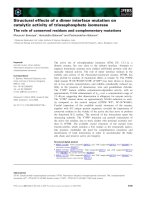
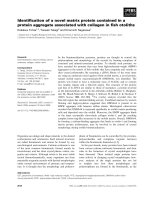
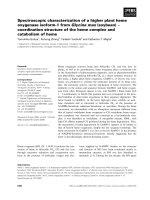
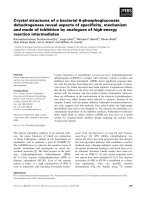

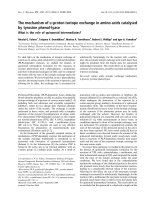

![Tài liệu Báo cáo khoa học: Specific targeting of a DNA-alkylating reagent to mitochondria Synthesis and characterization of [4-((11aS)-7-methoxy-1,2,3,11a-tetrahydro-5H-pyrrolo[2,1-c][1,4]benzodiazepin-5-on-8-oxy)butyl]-triphenylphosphonium iodide doc](https://media.store123doc.com/images/document/14/br/vp/medium_vpv1392870032.jpg)
